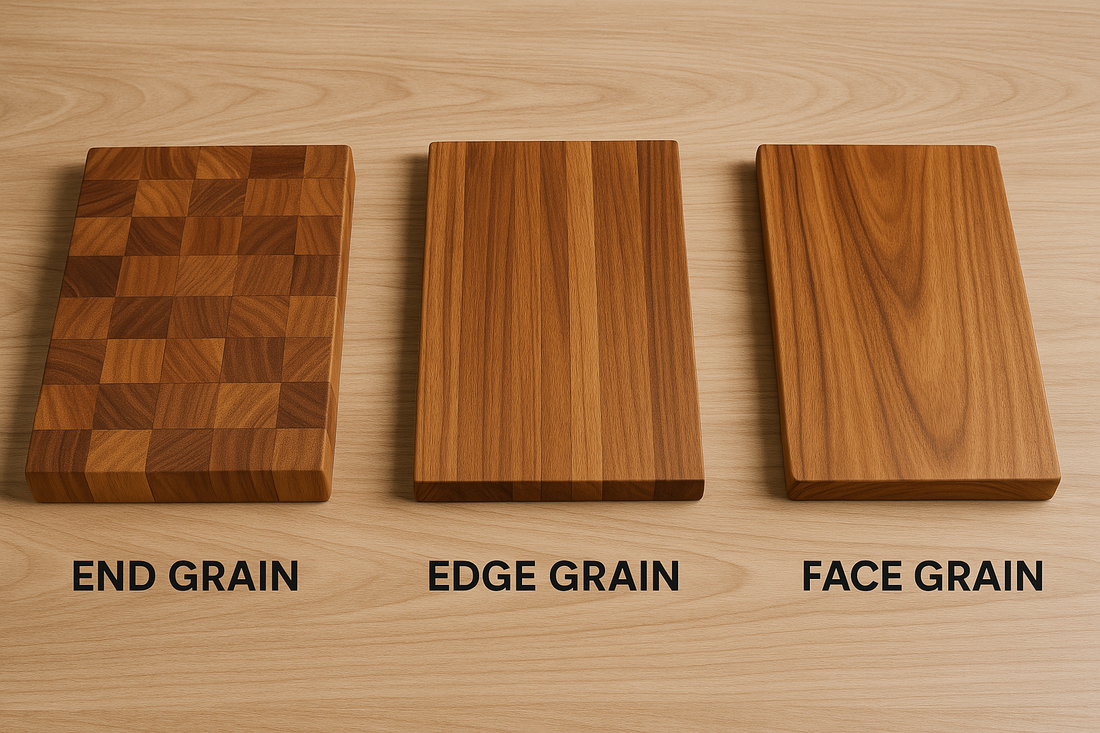
Share
End Grain vs Edge Grain vs Face Grain Wooden Chopping Boards: What’s the Difference?
Not all wooden chopping boards are created equal — and the way the wood is cut matters just as much as the type of wood itself. If you've come across the terms end grain, edge grain, and face grain, you're not alone in wondering what they mean and how they impact performance.
In this guide, we’ll break down the differences, pros and cons of each, and help you decide which one is right for your kitchen — especially if you're eyeing a premium teak board.
🪵 The 3 Types of Wood Grain for Chopping Boards
Wood is a natural material made of fibers, and depending on how the board is constructed, it can behave differently in use and appearance. Here’s how:
🔳 End Grain: The Professional’s Favorite
What it is:
End grain boards are made by arranging small blocks of wood so the grain runs vertically. When you cut on it, you're slicing between the wood fibers rather than against them.
- ✅ Extremely gentle on knife edges
- ✅ Self-healing: knife marks close up over time
- ✅ Beautiful, checkerboard-like pattern
- ✅ Durable and long-lasting with proper care
Cons: Typically more expensive and heavier than other boards.
Best For: Chefs, serious home cooks, and anyone who wants a premium cutting experience.
➖ Face Grain: Naturally Beautiful and Everyday Practical
What it is:
Face grain boards use the wide, flat surface of the wood. This creates a clean, natural-looking surface with visible wood patterns.
- ✅ Smooth, stunning grain patterns — ideal for display
- ✅ Lightweight and easy to handle
- ✅ More affordable than end grain
Cons: Slightly more prone to visible knife marks; not ideal for heavy chopping.
Best For: Light prep, serving boards, charcuterie, or anyone who values aesthetics and easy handling.
🔲 Edge Grain: The Middle Ground (But We Don’t Use It)
What it is:
Edge grain boards are constructed with long wood planks turned on their sides. They’re common in many commercial wooden boards.
- ✅ A bit more durable than face grain
- ✅ Less expensive than end grain
Cons: Harder on knives, and can warp if not properly maintained.
Best For: Budget-conscious users who want something tougher than face grain, but more affordable than end grain.
🧠 So... Which One Should You Choose?
| Grain Type | Knife-Friendly | Durability | Aesthetic | Ideal Use |
|---|---|---|---|---|
| End Grain | ✅✅✅ | ✅✅✅ | ✅✅ | Daily chopping, heavy use |
| Face Grain | ✅✅ | ✅ | ✅✅✅ | Light prep, serving |
| Edge Grain | ✅ | ✅✅ | ✅ | General use (not sold at Javanti Kayu) |
🏆 Why We Craft End & Face Grain Teak Boards at Javanti Kayu
At Javanti Kayu, we believe in quality that lasts — and looks incredible while doing it. That’s why we only sell end grain and face grain chopping boards made from premium teak wood.
- 🌿 Teak is naturally rich in oils → better water resistance
- 🪵 End and face grain give you options depending on how you cook
- 🧵 Every board is handcrafted for beauty, durability, and function
Conclusion
Choosing the right board comes down to how you use it. If you’re prepping daily meals, go with end grain teak. If you want a beautiful multipurpose board that doubles as a serving piece, try face grain teak.
Either way, you’re getting top-quality craftsmanship built to last.
Explore our full collection of teak chopping boards here.